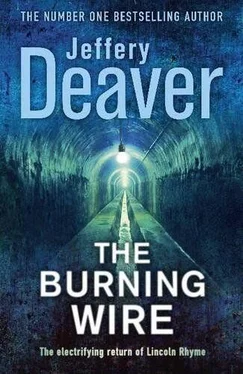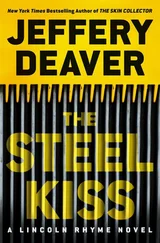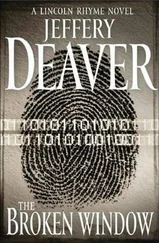Jeffery Deaver - The burning wire
Здесь есть возможность читать онлайн «Jeffery Deaver - The burning wire» весь текст электронной книги совершенно бесплатно (целиком полную версию без сокращений). В некоторых случаях можно слушать аудио, скачать через торрент в формате fb2 и присутствует краткое содержание. Жанр: Триллер, на английском языке. Описание произведения, (предисловие) а так же отзывы посетителей доступны на портале библиотеки ЛибКат.
- Название:The burning wire
- Автор:
- Жанр:
- Год:неизвестен
- ISBN:нет данных
- Рейтинг книги:5 / 5. Голосов: 1
-
Избранное:Добавить в избранное
- Отзывы:
-
Ваша оценка:
- 100
- 1
- 2
- 3
- 4
- 5
The burning wire: краткое содержание, описание и аннотация
Предлагаем к чтению аннотацию, описание, краткое содержание или предисловие (зависит от того, что написал сам автор книги «The burning wire»). Если вы не нашли необходимую информацию о книге — напишите в комментариях, мы постараемся отыскать её.
The burning wire — читать онлайн бесплатно полную книгу (весь текст) целиком
Ниже представлен текст книги, разбитый по страницам. Система сохранения места последней прочитанной страницы, позволяет с удобством читать онлайн бесплатно книгу «The burning wire», без необходимости каждый раз заново искать на чём Вы остановились. Поставьте закладку, и сможете в любой момент перейти на страницу, на которой закончили чтение.
Интервал:
Закладка:
The burning wire
Jeffery Deaver
I
Chapter 1
SITTING IN THE control center of Algonquin Consolidated Power and Light's sprawling complex on the East River in Queens, New York, the morning supervisor frowned at the pulsing red words on his computer screen. Critical failure.
Below them was frozen the exact time: 11:20:20:003 a.m.
He lowered his cardboard coffee cup, blue and white with stiff depictions of Greek athletes on it, and sat up in his creaky swivel chair.
The power company control center employees sat in front of individual workstations, like air traffic controllers. The large room was brightly lit and dominated by a massive flat-screen monitor, reporting on the flow of electricity throughout the power grid known as the Northeastern Interconnection, which provided electrical service in New York, Pennsylvania, New Jersey and Connecticut. The architecture and decor of the control center were quite modern-if the year were 1960.
The supervisor squinted up at the board, which showed the juice arriving from generating plants around the country: steam turbines, reactors and the hydroelectric dam at Niagara Falls. In one tiny portion of the spaghetti depicting these electrical lines, something was wrong. A red circle was flashing. Critical failure…
"What's up?" the supervisor asked. A gray-haired man with a taut belly under his short-sleeved white shirt and thirty years' experience in the electricity business, he was mostly curious. While critical-incident indicator lights came on from time to time, actual critical incidents were very rare.
A young technician replied, "Says we have total breaker separation. MH-Twelve."
Dark, unmanned and grimy, Algonquin Consolidated Substation 12, located in Harlem-the "MH" for Manhattan-was a major area substation. It received 138,000 volts and fed the juice through transformers, which stepped it down to 10 percent of that level, divided it up and sent it on its way.
Additional words now popped onto the big screen, glowing red beneath the time and the stark report of the critical failure. MH-12 offline.
The supervisor typed on his computer, recalling the days when this work was done with radio and telephone and insulated switches, amid a smell of oil and brass and hot Bakelite. He read the dense, complicated scroll of text. He spoke softly, as if to himself, "The breakers opened? Why? The load's normal."
Another message appeared. MH-12 offline. RR to affected service area from MH-17, MH-10, MH-13, NJ-18.
"We've got load rerouting," somebody called unnecessarily.
In the suburbs and countryside the grid is clearly visible-those bare overhead high-tension wires and power poles and service lines running into your house. When a line goes down, there's little difficulty finding and fixing the problem. In many cities, though, like New York, the electricity flows underground, in insulated cables. Because the insulation degrades after time and suffers groundwater damage, resulting in shorts and loss of service, power companies rely on double or even triple redundancy in the grid. When substation MH-12 went down, the computer automatically began filling customer demand by rerouting the juice from other locations.
"No dropouts, no brownouts," another tech called.
Electricity in the grid is like water coming into a house from a single main pipe and flowing out through many open faucets. When one is closed, the pressure in the others increases. Electricity's the same, though it moves a lot more quickly than water-nearly 700 million miles an hour. And because New York City demanded a lot of power, the voltages-the electrical equivalent of water pressure-in the substations doing the extra work were running high.
But the system was built to handle this and the voltage indicators were still in the green.
What was troubling the supervisor, though, was why the circuit breakers in MH-12 had separated in the first place. The most common reason for a substation's breakers to pop is either a short circuit or unusually high demand at peak times-early morning, both rush hours and early evening, or when the temperature soars and greedy air conditioners demand their juice.
None of those was the case at 11:20:20:003 a.m. on this comfortable April day.
"Get a troubleman over to MH-Twelve. Could be a bum cable. Or a short in the-"
Just then a second red light began to flash. Critical failure. NJ-18 offline.
Another area substation, located near Paramus, New Jersey, had gone down. It was one of those taking up the slack in Manhattan-12's absence.
The supervisor made a sound, half laugh, half cough. A perplexed frown screwed into his face. "What the hell's going on? The load's within tolerances."
"Sensors and indicators all functioning," one technician called.
"SCADA problem?" the supervisor called. Algonquin's power empire was overseen by a sophisticated Supervisory Control and Data Acquisition program, running on huge Unix computers. The legendary 2003 Northeast Blackout, the largest ever in North America, was caused in part by a series of computer software errors. Today's systems wouldn't let that disaster happen again but that wasn't to say a different computer screwup couldn't occur.
"I don't know," one of his assistants said slowly. "But I'd think it'd have to be. Diagnostics say there's no physical problem with the lines or switchgear."
The supervisor stared at the screen, waited for the next logical step: letting them know which new substation-or stations-would kick in to fill the gap created by the loss of NJ-18.
But no such message appeared.
The three Manhattan substations, 17, 10 and 13, continued alone in providing juice to two service areas of the city that would otherwise be dark. The SCADA program wasn't doing what it should have: bringing in power from other stations to help. Now the amount of electricity flowing into and out of each of those three stations was growing dramatically.
The supervisor rubbed his beard and, after waiting, futilely, for another substation to come online, ordered his senior assistant, "Manually move supply from Q-Fourteen into the eastern service area of MH-Twelve."
"Yessir."
After a moment the supervisor snapped, "No, now."
"Hm. I'm trying."
"Trying. What do you mean, trying?" The task involved simple keyboard strokes.
"The switchgear's not responding."
"Impossible!" The supervisor walked down several short steps to the technician's computer. He typed commands he knew in his sleep.
Nothing.
The voltage indicators were at the end of the green. Yellow loomed.
"This isn't good," somebody muttered. "This's a problem."
The supervisor ran back to his desk and dropped into his chair. His granola bar and Greek athlete cup fell to the floor.
And then another domino fell. A third red dot, like a bull's-eye on a target, began to throb, and in its aloof manner the SCADA computer reported: Critical failure. MH-17 offline.
"No, not another one!" somebody whispered.
And, as before, no other substation stepped up to help satisfy the voracious demands of New Yorkers for energy. Two substations were doing the work of five. The temperature of the electric wires into and out of those stations was growing, and the voltage level bars on the big screen were well into the yellow. MH-12 offline. NJ-18 offline. MH-17 offline. RR to affected service areas from MH-10, MH-13.
The supervisor snapped, "Get more supply into those areas. I don't care how you do it. Anywhere."
A woman at a nearby control booth sat up fast. "I've got forty K I'm running through feeder lines down from the Bronx."
Forty thousand volts wasn't much and it would be tricky to move it through feeder lines, which were meant for about a third that much voltage.
Читать дальшеИнтервал:
Закладка:
Похожие книги на «The burning wire»
Представляем Вашему вниманию похожие книги на «The burning wire» списком для выбора. Мы отобрали схожую по названию и смыслу литературу в надежде предоставить читателям больше вариантов отыскать новые, интересные, ещё непрочитанные произведения.
Обсуждение, отзывы о книге «The burning wire» и просто собственные мнения читателей. Оставьте ваши комментарии, напишите, что Вы думаете о произведении, его смысле или главных героях. Укажите что конкретно понравилось, а что нет, и почему Вы так считаете.












